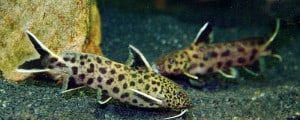
Common name: Dwarf Lake Synodontis, False Cuckoo Synodontis
Scientific name: Synodontis Petricola
Average Adult Fish Size: 5 inches / 13 cm
Place of Origin: Lake Tanganyika, Africa
Typical Tank setup: Rocky African biotope with caves, roots/bogwood/driftwood and plants.
Recommended Minimum Aquarium Capacity: 20 gallon / 80 litre
Compatibility: Peaceful, but will eat small fish. Makes a good community tank fish if kept with other hard-alkaline water species.
Temperature: 75 – 82 Deg F / 24 – 28 Deg C
Water chemistry: pH 7.5 – 8.5
Feeding: In their native habitat they live on a crustacean diet of snails as do other Lake Tanganyika catfish and will do well in the aquarium on a diet of frozen foods such as shrimp, brine shrimp and mysis. They will also accept catfish tablets, pellets, and a good quality flake food.
Sexing: Females are usually fuller bodied and males more slender, but venting with a strong magnifying glass is the only accurate way to sex Petricola.
Breeding: Unlike the majority of the genus, S. petricola is actually bred quite regularly in aquaria. It is usually an open spawning egg scatterer but it is also one of the few fish known to exhibit a method of spawning known as brood parasitism. The others also being Tanganyikan Synodontis species! The catfish times its spawning to coincide with that of a ‘host’ mouthbrooding cichlid and lays its eggs among those of the host fish. The Syno eggs hatch much quicker than the cichlids’ and the young catfish quickly devour all the mouthbrooder’s eggs. The unwitting cichlid then guards the fry as if they are their own.
However, in aquaria by far the most productive method of breeding is to set up a separate breeding tank and try and raise all the eggs. The tank can be quite simple but should contain hiding places in the form of rock piles or terracotta pots. Water should be kept very clean with minimal nitrates. The fish can be spawned in pairs or groups (flock spawning) and whichever method is used, they should be brought into condition with plenty of live and frozen foods.
Spawning itself occurs following some chasing by the male. The fish adopt a similar stance to the “T” position seen in Corydoras breeding. The male grabs the female around the head area and eggs and sperm are released. They may also be seen lying alongside each other, quivering as spawning takes place. The adult fish should be removed once the spawn is complete in order to avoid egg predation.
The eggs hatch in around 24 hours with the fry becoming free swimming 2-3 days later. They are very small and should be offered infusoria for the first couple of days, followed by baby brine shrimp (BBS), and powdered flake. They are fairly slow growing and it may take 6 months or more to reach a decent size.
Additional Information: It is very similar to the other popular Synodontis from the same Lake, the ‘Cuckoo Cat’ – Synodontis multipunctatus, but petricola has white edgings to all its fins, especially the leading ray of the dorsal, whereas Synodontis multpunctatus has white only on the rear end of the dorsal fin, and has larger eyes. Petricola needs caves or rock work to feel secure. Keep nitrates low with frequent partial water changes.

Related Posts
Croaking Gourami – Trichopsis vittatus
Paradise Fish – Macropodus opercularis
Schubert’s Barb – Barbus Semifasciolatus